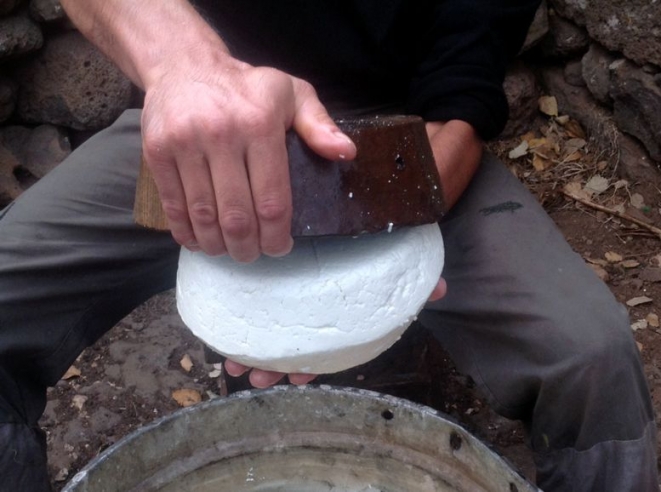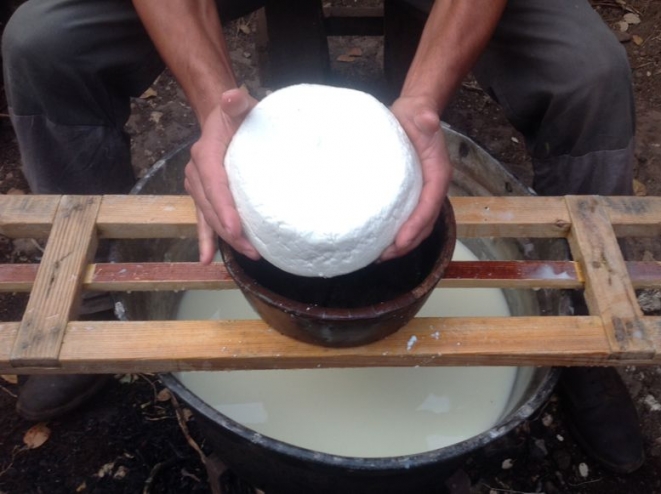Artisanal cheese by Salvatore Ledda
The tradition that endures
The plateau of Giara, at a height of six hundred meters, in the heart of Sardinia, there are still those who produce an excellent cheese with the same techniques that were used hundred years ago.
Salvatore, Tore according to his friends, managed to maintain and preserve this centuries-old knowledge and revive in our time the ancient tradition of cheese production.
Cheese is one of the elements that have always characterized the cuisine of Sardinia. A flagship and a product of excellence in the tradition and Sardinian cuisine.
It is a unique experience to know and follow the gestures and the steps that mark the transformation of milk into cheese. There is involved so much passion and wisdom. Archaic gestures are identical for every shepherd, etched in the mind, which alternate the deepest silence.

We have followed step by step in this beautiful procedure.
At dawn, after milking the goats and having gathered the firewood, the shepherd lights the fire and places at the center of the flame the tripod. The milk, given the fact that it already has a right temperature, (as it is ejected from the breast reaches 37°) is made to heat up just a few minutes.
Then it is curdled, which is add a certain amount of rennet in the bowl. Tore, with a smile, does not reveal the amount of rennet poured. Every ten liters of milk there is a precise quantity of rennet to be added that Tore, however, cannot reveal it to us. He says it is a family secret and that allows him to get a good finished product. The success of a cheese depends partly also from this.
The next step is to turn off the fire.
Then the curd is left to rest for twenty-five minutes. They are moments of silence and meditation for the shepherd.
Upon expiry of this time frame, the curd is whisked by hand, with regular movements, waiting for a further adjustment.
At completed settle, the shepherd plunges his hand inside the bowl, it performs a propitiatory gesture for the good outcome of the cheese and with the same hand divides the curd into four parts.
At that point it reduces these pieces into smaller portions, so as to work better the mixture. The manufactured parts are inserted into the "aiscu", a drilled oak bowl.
After the curd is inserted inside the bowl, the shepherd will begin to "prick" the dough with the fingers to separate the whey from the curd. The liquid drips through the holes of the bowl, in the vat called in Sardinian language the craddaxiu.
From the vat he continues to draw, with both hands, the curds that is pressed vigorously to reach and exceed the edge of the bowl, from which will be extracted the cheese wheel. After a few minutes the content is flip over the and the operation is repeated a few times. It is a critical step. The compound, to ensure a compact cheese wheel, must be pressed properly.
After this step the cheese wheel is turned upside down for a last time than is left at rest to drain all the whey.

At this point the young shepherd lights up again the fire, to boil the whey and extracts the ricotta depositing it in special handcrafted baskets. The cheese can now be plunged in the boiling whey. This step is important to give firmness to the skin and assure a nice golden color. The fire is then putted out.
About one minute after the cheese is pulled out and immerged in a brine of salt and water, (sa mruxia) for twenty-four hours. It is good that is left twelve hours by a side and twelve on the other.
After this time it is taken out and dried in a special basket of wood: the "cantareddu". After twenty days the cheese is ready to be eaten fresh.
In the past this kind of goat cheese, in large part, was marketed. Today, the big dairy industries have replaced the traditional cheese production and is increasingly difficult to find shepherds who produce with these methods.
After a few weeks we go back in "su coile" (the sheepfold) of Salvatore. Some forms dry. Everything is in order. The smell that you breathe is one of those ancient, pleasant, a fragrance full of ancient wisdom from the past and lived life.
And here is that cheese wheel that came to life just twenty days before. The same hand of the shepherd who has milked the breast now cuts the cheese: the cycle is finally concluded.